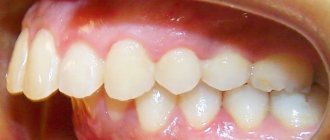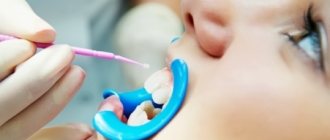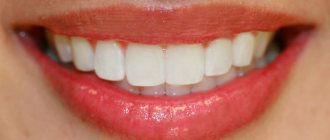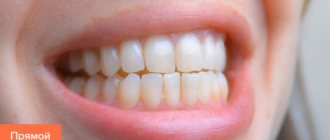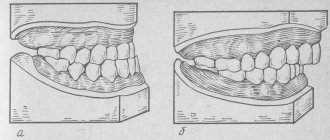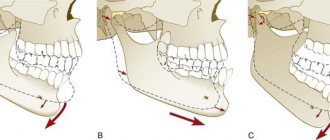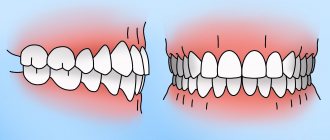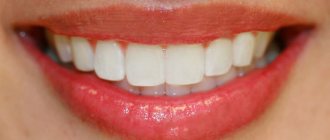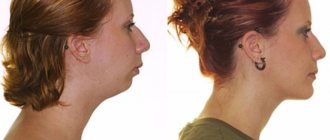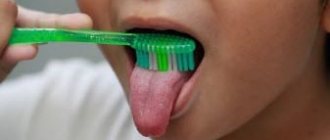Publication date: June 28, 2021.
Information on this page was updated on September 13, 2021.
Our patients most often come with a complaint about uneven teeth, because it is visible and understandable. But it is possible to have visually even rows of teeth, which at the same time do not close correctly, and in three planes. The closing of the teeth is called a bite.
A deep bite is a violation of the closure of teeth in the vertical plane. With a normal bite, the upper incisors overlap the lower incisors by about one third. In this state, the incisors ideally perform their function: they can bite off even a thin piece.
But with a deep bite, the upper front teeth overlap the lower ones by more than half the crown. This is already considered a pathology, the teeth do not perform their functions, the aesthetics and general health of the oral cavity deteriorate.
What is a deep bite?
People strived for a perfect smile back in ancient times, evidence of this is found in mummies from Ancient Egypt, which had ropes obtained from animal intestines entwined around their teeth.
They played the role of modern dental wires for braces. Now it is much easier to correct a deep bite. To achieve faster and more effective results, you need to start treatment from childhood. A deep bite is an anomaly that manifests itself in the form of overlap of the lower dentition with the upper one.
The defect can be diagnosed when there is an overlap of more than 1/3 of the height of the crowns. The “lucky” one with a deep bite experiences discomfort while chewing food, speech impediments, and injuries to the gums and palate.
Kinds
Orthodontists distinguish the following types of this pathology:
- incisal overlap – contact of the cutting edge of the lower arch with the palatine tubercles is preserved;
- deep bite – there is no incisal-tubercle contact;
- deep traumatic - the cutting edges of the lower teeth rest against the palate.
If treatment is not carried out, then all these stages in most cases alternately replace each other in the indicated order, therefore the incisal overlap is considered the beginning of pathological changes, and the traumatic type is the result of a long course.
Depending on the amount of crown overlap, the following 3 degrees are distinguished:
- I – overlap up to 5 mm deep;
- II – overlap 5-9 mm;
- III – overlap over 9 mm.
A distinction is made between anterior occlusion, when the overlap is observed in the frontal zone, and lateral, if the violation is detected in the lateral region. With this deviation and simultaneous reduction of the anterior teeth of the lower jaw, we are talking about sagittal disocclusion. This phenomenon is often observed in children with a milk supply.
Abnormal occlusion of the dental radii in the sagittal direction (lateral segment)
Orthodontists also distinguish distal and neutral types of pathology. With distal, the oval of the face seems narrower, and the chin remains unchanged, while with neutral, the oval looks shortened. Distal is usually more noticeable, while neutral requires an orthodontic examination to confirm.
Causes of deep bite
Such an unpleasant phenomenon as a problem bite can appear both in childhood and in older age. In dentistry, there are several reasons that can lead to the development of pathology:
- birth defects associated with facial deformation;
- genetic inheritance of the specific structure of the dental system;
- improper dental prosthetics;
- delay in prosthetics.
Also, the causes of a deep, incorrectly formed bite can be constant finger sucking and lip biting. Even a pacifier can lead to the development of occlusion. The pathology does not go away on its own, but fortunately orthodontics is now very well developed, making it possible to effectively eliminate the manifestations of deep bite.
Classification of deep bite
According to the nature of origin, a deep bite can be:
- Primary – develops for reasons of irregular structure in the facial skeleton and dentition. The anomaly is most often represented by a deep blocking bite, which is manifested by limitation of jaw movements other than closing and opening. This pathological occlusion comes in two forms: dentoalveolar and skeletal deep bite.
- Secondary. The main reason for the formation of such a bite is due to previous diseases of the dental system. This could be periodontal disease, tooth loss, etc.
There is also a classification of deep bite according to the type of interaction of the lateral dentition:
- Distal - with this form of bite, the upper row of teeth overlaps the lower row by the length of the crown. The pathology is characterized by an underdeveloped lower jaw, a slightly sloping chin, a shortened face, and exposure of the crowns to the neck when smiling.
- Neutral - with such a bite, there are no pronounced defects in the skeletal structure of the face, its lower part is slightly shortened, and the chin is of a normal shape.
The stages of development of deep bite are divided into initial, progressive and traumatic.
What is the pathology characterized by?
Deep bite is a type of disocclusion, which is characterized by excessive overlap of the upper teeth with the lower ones.
This type of violation has other names:
- deep incisal occlusion;
- declining;
- traumatic;
- deep incisal (frontal) overlap.
Occasionally, excessive overlap is detected on the side of the lateral teeth. It is believed that in infancy, up to 80% of babies have a similar disorder. In some of them, as they grow and develop, this anomaly disappears by the time the permanent bite is formed. The rest require orthodontic correction. The baby should be regularly shown to the dentist in order to identify the need for it in time.
Deep bite in children
The cause of deep occlusion can be birth trauma, a long period of sucking a pacifier or finger, late loss of baby teeth, calcium deficiency, or trauma to the dental system. In 15% of schoolchildren, a distal deep bite is diagnosed - the upper jaw is strongly pushed forward. It can develop against the background of impaired nasal breathing, adenoids, enlarged tonsils, frequent colds, and rickets. Also, improper formation of the bite can be caused by the removal of teeth at an early age, or the habit of propping up the chin.
Symptoms of deep bite
Externally, improper closure of teeth is manifested by shortening of the lower third of the face, the formation of a pronounced supramental fold, and turning of the lower lip outward. Among the oral signs:
- overlap of the lower frontal dentition with the upper one by the size of the crown;
- inflammatory process of the mucous membranes of the mouth;
- rapid erosion of tooth enamel, which leads to the development of caries;
- excessive overhang of the upper jaw over the lower jaw;
- decrease in the depth of the vestibule of the oral cavity.
Also, with malocclusion, secondary symptoms appear that develop against the background of the primary ones: problems with diction, breathing, deformation of the cranial vault, pain while chewing food.
Diagnosis of deep bite
Occlusion can be determined by external signs, but not all forms of improper closure of teeth are pronounced, so additional diagnostics are required. The specialist examines the patient’s medical history and conducts a visual examination of the oral cavity. The following activities can be carried out:
- taking an impression with alginate mass, followed by making diagnostic models and measuring them;
- photo of the face in profile and front;
- X-ray examinations;
- measurement of dental arches, apical base;
- performing an occludogram.
When making a diagnosis, data obtained from the results of electromyography, orthopantomography and teleradiography play an important role.
Consequences of deep bite
Elimination of deep occlusion is necessary not only to achieve an aesthetic result, but also to treat phenomena that bring a lot of discomfort in everyday life. Teeth that do not fit properly can cause the development of speech defects, facial asymmetry, and various aesthetic deviations. Besides:
- a large load on the front teeth provokes increased sensitivity and rapid abrasion of the enamel, which leads to caries;
- Loose teeth and frequent inflammatory processes in the gums appear against the background of their constant injury.
The pathology also leads to a decrease in the height of the bite, headaches, tooth wear and subsequent loss of tone of the masticatory muscles.
Complications
Reduced bite is a rather dangerous pathological condition. If nothing is done, serious complications arise.
The following problems begin:
- violation of diction;
- high load on the incisors;
- facial disproportions;
- inflammatory pathologies of the gums;
- pathological mobility of teeth;
- trauma to the oral mucosa;
- breathing and swallowing problems;
- headache;
- dysfunction of the maxillary joint;
- pathological abrasion of incisors.
All these complications can provoke numerous complexes in the child and complicate his relationships with peers.
Treatment of deep bite
For deep bites in adults, braces are usually used. A very interesting fact is that for the manufacture of certain types of braces, nickel-titanium is used - a material created by NASA for use in space. Clear aligners can also be used, which are more aesthetically pleasing. In addition, they are convenient, as they can be removed when eating or brushing your teeth. It takes at least 12-14 months to correct improper closure. The effectiveness of treatment and its duration depend on the degree of pathology and the correct choice of orthodontic design. To achieve a good result, it is important for the patient to comply with the rules established by the treating dentist. Treatment of deep bite in children is simpler, since the dentition is not yet fully formed; the course of occlusion can be influenced by the following methods:
- the child needs to be accustomed to solid food in order to create optimal stress on the teeth;
- it is important to cure dental caries;
- during the change of baby teeth, plates or other orthodontic structures (Frenkel, Bruckle, trainers) are installed on molars;
- At the age of 12 years, vestibular and lingual braces can be installed.
The iOrtho network of clinics selects the most effective treatment method taking into account the specific situation. We provide high-quality services and a modern treatment method using Invisalign aligners. Book your consultation now to enjoy a beautiful smile in just a few months.
Treatment errors
When turning to inexperienced specialists, you may be faced with the selection of the wrong treatment method. If there is a mistake in choosing devices such as occlusal pads, crowns, mouthguards for children, their large molars and incisors may become separated. This leads to rapid erasure of the cusps on the antagonist teeth located in the lateral row. In the anterior part, on the contrary, there is a sharp separation of the teeth and their protrusion forward, worsening the incisal overlap.
Deep bites in adults and teenagers can only be completely corrected if there is enough space underneath. Once the jaw has formed, some teeth will need to be removed to gain sufficient space. You also need to take into account the fact that when removing tooth protrusion in the anterior part of the dentition, the incisal overlap increases.
The effectiveness of treatment using the Herbst apparatus
Deep overbites are often corrected using the Herbstat appliance, a permanent orthodontic appliance. To correct the occlusion, it must be worn for at least 3-12 months. Its main task is to restrain the growth of the upper jaw, correct the lower jaw, and rebuild the functioning of the muscles of the dental system. The choice of this treatment method allows you to accurately predict the result and achieve it in a short time. The device does not interfere with eating or talking.
The cost of braces: a brief overview
Of course, it is impossible to give exact prices at the moment: the cost of all braces, as well as dental services, is gradually increasing. In addition, the final amount depends on the condition of the teeth and the final design of the braces. But general information can be provided.
The most affordable braces systems are classic ones, which are classified as ligature, are installed on the outside of the teeth and are made of medical steel. Their cost ranges from several thousand rubles. Plastic systems of the same type cost approximately the same.
Ceramic ones will be more expensive - the bill will already be several tens of thousands of rubles. Sapphire ones will be slightly more expensive. Titanium and gold cost even more due to high prices for materials.
However, the cost is affected not only by the material from which the braces are made. In particular, you will have to spend at least 40 thousand rubles on non-ligature systems, even if they are created from ordinary medical steel. The reason is a more complex design and high requirements for the product. The same applies to lingual systems: they must be much smaller, but must provide the same fixation and pressure as conventional vestibular braces. Their cost can exceed 100 thousand rubles.
More accurate information on prices can be found by going to the price list section, or by contacting our manager by phone.
Forecast and prevention of deep bite
The prognosis of a deep pathological bite when choosing the right treatment method is always positive. It is possible to correct incorrect teeth closure even in adulthood, but in order for the result to be of better quality, treatment must begin in the first stages of its development. Prevention is also important, it is necessary to control the loss of baby teeth and the correct growth of molars, monitor the position of the child’s head during sleep, protect him from bad oral habits, in particular prolonged sucking of a pacifier and thumb, it is important to promptly treat ENT diseases and other pathologies that can cause the development of a deep bite.
These include:
- prolonged sucking of a pacifier and foreign objects (pencil, finger);
- bad habits (biting your lip, resting your chin on your hand);
- early loss of molars;
- pathology of ENT organs;
- abnormalities of the musculoskeletal system;
- severe caries of molars;
- skull injuries;
- malignant tumors of the skull bones;
- consequences of rickets;
- inflammatory diseases of the jaw bones;
- untimely teething;
- defect in the attachment of the frenulum of the lips and tongue;
- congenital anomalies of the facial skeleton.
It is necessary to identify the cause of the development of the pathology; corrective measures depend on this.
